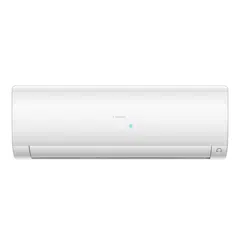Loading ...
Loading ...
Loading ...

SEQUENCE of OPERATION
System Power
The 230 Volt AC power for the system connects to terminals
1(N), 2(L), and ground of the outdoor unit terminal block. This
terminal block also has terminals to connect power to the
indoor unit.
The voltage readings between terminals 1(N) and ground, and
●
terminals 2(L) and ground should be 120 VAC. The voltage
reading between terminals 1(N) and 2(L) should be 230 VAC.
●
One additional connection on the terminal block (3) is for the
communication wire between the indoor and outdoor units.
NOTE: Mis-wiring of these connections may cause improper
operation or damage to system components.
Cool Mode
Overview
The temperature control range in cooling mode is 60°F - 86°F.
The temperature set by the remote control and the indoor
unit ambient temperature sensor will determine if a call for
cooling is needed. If a call for
communicated from the indoor unit to the outdoor unit. The
indoor unit louver will open using a stepper motor, and the
●
indoor fan will operate at the speed last set. The outdoor unit
will determine the position of the EEV and speed frequency
of the compressor. There can be a delay of up to 3 minutes
before the outdoor unit fan and compressor start.
●
The speed of the indoor fan can be controlled manually by
the user or automatically by the system. The speed can be
●
changed between LOW, MEDIUM, and HIGH.
The predetermined conditions for automatic control are
as follows:
(Tr= room temperature Ts= set temperature)
High Speed: Tr
Ts + 5.4°F
Medium Speed: Ts + 1.8°F
Tr < Ts + 5.4°F
Low Speed: Tr
Ts + 1.8°F or when the sensor is
There will be a 2 second delay when manually controlling the
speed.
The outdoor unit temperature sensors: outdoor ambient,
defrost, suction line, and compressor discharge, used in
conjunction with the indoor temperature sensors, indoor
ambient and coil, provide information to the outdoor control
board to monitor the system and regulate the frequency of
the compressor, the EEV, and outdoor fan speed, to
achieve
the desired room temperature.
followed by the outdoor fan. The indoor unit fan
will continue to run.
If the system detects a malfunction, it may shut down or
show an error code. This code will be shown on the indoor di-
Indoor Unit
To enter the cool mode, point the infrared remote control at
the indoor unit and press the power button, then press the
COOL mode button if not already set to cool mode.
The signals received by the infrared receiver are relayed to
the main board of the indoor unit to turn the system on and
set it to cool mode.
The indoor will illuminate the display, indicating
the set temperature and current status of the unit.
The to open the louver to
either a stationary position, or one of several oscillating
modes.
As the louver opens, the indoor unit main board will power up
the indoor fan motor, operating the fan at the speed last set.
The indoor fan motor has a feedback circuit which provides
the indoor unit main board with information for controlling
the speed of the fan motor.
Temperature Sensors
The indoor unit has two sensors that provide temperature
information to the main board. The sensors: an indoor ambi-
ent temperature sensor, and pipe temperature sensor, are
used for controlling the system during cool mode.
The resistance values of the sensors will vary with tempera-
ture. The resistance to temperature values can be found
to the sensor
being checked.
Communication
The indoor and outdoor unit main boards communicate via a
digital signal on the wire connected to terminal 3 of each unit.
A splice or break in this wire will cause a communication error.
When a command is received from the remote control, the
indoor unit main board communicates with the outdoor unit
main board to perform the requested function.
Outdoor Unit
Upon a request for cooling, the outdoor unit main board ap-
plies power to the outdoor fan motor
and compressor. Depending on system cycling, there may
be up to a 3 minute wait period before the compressor and
outdoor fan start.
WARNING: Do not measure compressor voltages as damage
to the meter may result.
If the room temperature is less than the set temperature,
yet higher than 2°F below the set temperature, the system
will adjust the speed of the compressor automatically.
>=
PAGE 63
Loading ...
Loading ...
Loading ...
